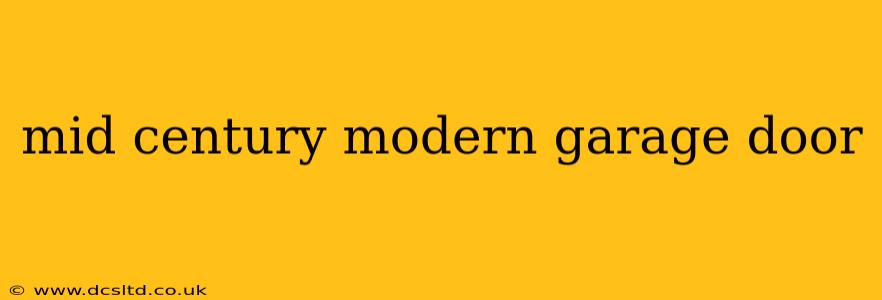The garage door—often overlooked—can be a powerful statement piece, especially when embracing the timeless elegance of mid-century modern design. This architectural style, flourishing from roughly the 1930s to the 1960s, emphasizes clean lines, functionality, and a connection to nature. Translating these principles into your garage door choice can dramatically enhance your home's curb appeal and overall aesthetic. This guide explores the key elements of a mid-century modern garage door and helps you find the perfect fit for your home.
What Defines a Mid-Century Modern Garage Door?
Mid-century modern design prioritizes simplicity and functionality. When it comes to garage doors, this translates to:
- Clean Lines and Simple Shapes: Forget ornate detailing or complex patterns. Mid-century modern garage doors favor sleek, geometric forms, often featuring rectangular panels or horizontal lines.
- Natural Materials: Wood, particularly in natural tones like walnut or oak, is a hallmark of the style. However, materials mimicking wood's appearance, such as composite materials or painted steel, can also work effectively, offering durability and low maintenance.
- Neutral Color Palette: Earth tones, muted greens, grays, and creams are common choices, complementing the natural surroundings and enhancing the overall clean aesthetic. Bold colors can also work if used thoughtfully and in harmony with the home's exterior.
- Horizontal Emphasis: Horizontal lines visually extend the garage, creating a sense of spaciousness and modernity. Vertical lines, while not entirely excluded, are generally less prominent.
- Minimal Hardware: While functional hardware is necessary, it should be understated and unobtrusive. Avoid overly decorative handles or hinges.
What Materials Are Best for a Mid-Century Modern Garage Door?
Choosing the right material is crucial for achieving the desired aesthetic and functionality. Here's a breakdown:
- Wood: Offers a natural, warm look that is quintessential mid-century modern. However, it requires regular maintenance to prevent warping and damage.
- Steel: A durable and low-maintenance option. Steel doors can be painted to mimic the look of wood or finished in a variety of colors.
- Aluminum: Lightweight and corrosion-resistant. Aluminum doors can also be finished to look like wood or other materials.
- Composite: A blend of materials often including wood fibers and polymers. Composite doors offer a balance of durability, aesthetics, and low maintenance.
How Much Does a Mid-Century Modern Garage Door Cost?
The cost of a mid-century modern garage door varies widely depending on the material, size, and features. Expect to pay anywhere from a few hundred dollars for a basic steel door to several thousand for a custom-made wood door. Factors like insulation, automation, and window inserts will also impact the final price.
What are the different styles of mid-century modern garage doors?
Several styles can capture the essence of mid-century modern design. These include flush panel doors, carriage-style doors (with a simplified, modern interpretation), and doors with horizontal grooves or recessed panels. The key is to select a style that complements the overall architecture of your home.
What colors are best for a mid-century modern garage door?
Neutral tones such as beige, gray, and muted greens often work best, echoing the earthy palette of mid-century design. However, bolder colors can be effective if they complement the home's exterior and landscape.
How do I find a mid-century modern garage door installer?
Many garage door companies offer a variety of styles, including those inspired by mid-century modern design. Research local companies, review online ratings and testimonials, and compare quotes before making a decision. You might even consider a specialist in custom garage doors to achieve a truly unique look.
Are there any DIY options for creating a mid-century modern garage door?
While building a garage door from scratch is generally not recommended for DIY enthusiasts, you could potentially refinish an existing door to achieve a mid-century modern aesthetic. This would require painting, replacing hardware, and potentially adding simple panel details. However, this approach requires skill and patience.
By carefully considering the materials, colors, and overall style, you can choose a mid-century modern garage door that seamlessly integrates with your home's architecture and elevates its curb appeal. Remember that a well-chosen garage door is more than just a functional element; it’s a key component of your home's overall design statement.
